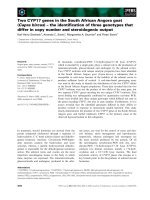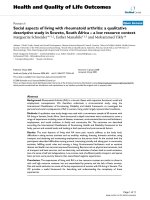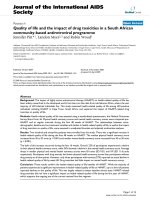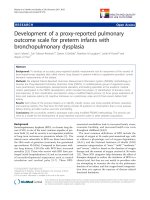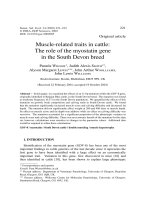Neurodevelopmental outcome of late preterm infants in Johannesburg, South Africa
Bạn đang xem bản rút gọn của tài liệu. Xem và tải ngay bản đầy đủ của tài liệu tại đây (620.66 KB, 6 trang )
Ramdin et al. BMC Pediatrics (2018) 18:326
/>
RESEARCH ARTICLE
Open Access
Neurodevelopmental outcome of late
preterm infants in Johannesburg, South
Africa
Tanusha Ramdin1, Daynia Ballot1* , David Rakotsoane1, Lethile Madzudzo1, Nicolette Brown1, Tobias Chirwa2,
Peter Cooper1 and Victor Davies1
Abstract
Background: Late preterm infants, previously considered low risk, have been identified to be at risk of developmental
problems in infancy and early childhood. There is limited information on the outcome of these infants in low and
middle income countries.
Methods: Bayley scales of infant and toddler development, version III, were done on a group of late preterm infants in
Johannesburg, South Africa. The mean composite cognitive, language and motor sub-scales were compared to those
obtained from a group of typically developed control infants. Infants were considered to be “at risk” if the composite
subscale score was below 85 and “disabled” if the composite subscale score was below 70. Infants identified with cerebral
palsy were also reported.
Results: 56 of 73 (76.7%) late preterm infants enrolled in the study had at least one Bayley assessment at a mean age of
16.5 months (95% CI 15.2–17.6). The mean birth weight was 1.9 kg (95%CI 1.8–2.0) and mean gestational age 33.0 weeks
(95% CI 32.56–33.51). There was no difference in the mean cognitive subscales between late preterm infants and controls
(95.4 9, 95% CI 91.2–99.5 vs 91.9.95% CI 87.7–96.0). There was similarly no difference in mean language subscales (94.5,
95% CI 91.3–97.7 vs 95.9, 95% CI 92.9–99.0) or motor subscales (96.2, 95% CI 91.8–100.7 vs 97.6, 95% CI 94.7–100.5). There
were four late preterm infants who were classified as disabled, two of whom had cerebral palsy. None of the control
group was disabled.
Conclusions: This study demonstrates that overall developmental outcome, as assessed by the Bayley scales of infant
and toddler development, was not different between late preterm infants and a group of normal controls. However, 7.1%
of the late preterm infants, had evidence of developmental disability. Thus late preterm infants in low and middle income
countries require long term follow up to monitor developmental outcome. In a resource limited setting, this may best be
achieved by including a parental screening questionnaire, such as the Ages and Stages Questionnaire, in the routine well
baby clinic visits.
Keywords: Infant, Premature. Child development, Follow-up studies, South Africa, Developmental disabilities
* Correspondence:
1
Neonatal Unit, Department of Paediatrics and Child Health, Charlotte
Maxeke Johannesburg Academic Hospital, School of Clinical Medicine,
University of the Witwatersrand, Johannesburg, South Africa
Full list of author information is available at the end of the article
© The Author(s). 2018 Open Access This article is distributed under the terms of the Creative Commons Attribution 4.0
International License ( which permits unrestricted use, distribution, and
reproduction in any medium, provided you give appropriate credit to the original author(s) and the source, provide a link to
the Creative Commons license, and indicate if changes were made. The Creative Commons Public Domain Dedication waiver
( applies to the data made available in this article, unless otherwise stated.
Ramdin et al. BMC Pediatrics (2018) 18:326
Background
One in every three pre-school children in low and middle income countries (LMICS) globally fails to meet normal milestones in socio-emotional and cognitive spheres
[1]. The majority of these infants were from sub-Saharan
Africa. Preterm birth is a potential risk factor for later
neurodevelopmental impairment. Until recently, late
preterm infants born between 34 and 37 completed weeks,
were considered to be at low risk of morbidity and developmental problems. There is, however, increasing evidence that late preterm infants (LPI) are at increased risk
of neonatal problems and poor neurodevelopmental function, in comparison to their term counterparts [2–5]. The
incidence of problems increases as gestational age decreases. Elective preterm delivery should therefore be discouraged, LPI should be discharged 48 h after birth and
have appropriate long term follow up [2, 3, 5]. In South
Africa, limited health resources necessitate measures to
reduce the workload of doctors. For example, very low
birth weight infants, who are at increased risk of complications, are discharged at earlier chronological ages and
lower weights compared to well-resourced settings [6]. In
the same context, apparently healthy neonates who are
considered to be low risk, including late preterm infants
(LPI), are not managed by medical staff but are routinely
examined by midwives at birth, discharged to their
mothers and followed up at the well-baby immunization
clinics.
There is a lack of data from LMICS on the long term
outcome of children who sustained insults in the neonatal
period; this is especially problematic in sub-Saharan Africa
[7]. In a middle income country, such as South Africa, improved health care has resulted in increased neonatal survival rates, but follow up data is lagging behind [7].
Reliable information on the burden of long term morbidity related to neonatal problems is therefore minimal [7].
There are three published systematic reviews of studies
evaluating the neurodevelopmental outcome of late preterm infants [3, 5, 8]. All three reviews concluded that
LPI are at increased risk of neurodevelopmental disability in comparison to their term counterparts and recommend closer follow up of these infants. Most of the
studies were conducted in high income countries, particularly the United States of America. There were no
studies from sub-Saharan Africa. The aim of this study
was therefore to determine the neurodevelopmental outcome of late preterm infants in Johannesburg, South
Africa in comparison to a group of term control infants.
Methods
This was a prospective follow up study conducted in the
neonatal unit of a tertiary hospital in Johannesburg,
South Africa. Late preterm infants (LPI) were defined as
those infants with a birth weight above 1500 g and a
Page 2 of 6
gestational age below 37 weeks. LPI who were born between 1 July 2013 and 30 June 2014 and had required
admission at birth, who were discharged from the neonatal unit were invited to attend the study clinic.
The study group comprised those LPI infants who had
attended at least one follow-up study clinic visit. Infants
with congenital abnormalities likely to affect neurodevelopment, in particular Trisomy 21, were excluded from
the study. A group of well term babies who had gone
home with their mothers after birth during the same
period were enrolled as a control group and followed up
at the same clinic. The developmental outcome of the
control group has been reported elsewhere [9].
Gestational age was assessed by maternal menstrual
history and clinical assessment using the Ballard score
[10, 11]. Infants were classified as appropriate for gestational age (AGA) or small for gestational age (SGA)
using the Fenton Growth calculator for preterm infants
( />Children were seen at the study clinic every three
months. Developmental assessment was done using the
Bayley scales of infant and toddler development, version III
(BSITD III). It was anticipated that a large number of children would drop out of the follow up study, so BSITD (III)
assessments were done at 9 to 12 months and then again at
15 to 18 months of age. If a child defaulted, the BSITD (III)
assessment would be done at the next visit. The BSITD
(III) assessments for both the study and control participants
were done by an appropriately trained physiotherapist or
paediatrician. A Cronbach’s alpha intra-class correlation of
0.89 was determined between different observers. The assessor was blinded to the participant’s neonatal history, including the gestational age. The BSITD (III) scores were
calculated using the age corrected for prematurity. In order
to ensure a reasonable rate of follow up, a text message was
sent to remind parents of the appointment, transport costs
were refunded and defaulting patients were traced and
rebooked. If developmental problems were identified, the
child was referred for appropriate intervention. The child’s
weight, height and skull circumference were measured at
each visit and plotted on World Health Organization
( growth charts; the growth parameters were
expressed as Z scores derived from these charts.
Sample size calculation
A previous study conducted in the same unit, found the
mean composite cognitive score in a group of very low
birth weight infants to be 89 with a standard deviation of
15 [12]. Assuming the mean of the control group to be 97,
a sample size of 44 would be required with α = 0.05 and β
= 0.80, to detect a significant difference between the means
[9]. Therefore a sample size of 50 participants was calculated for this study.
Ramdin et al. BMC Pediatrics (2018) 18:326
Page 3 of 6
Statistical analysis
Data was entered managed using Research Electronic
Data Capture (REDCap ™) software, hosted by the University of the Witwatersrand [13]. Data was exported
into IBM SPSS 23 for statistical analysis. The latest
BSITD (III) score for each child was used for the analysis. The composite cognitive, language and motor
scores were used as outcome variables. Continuous variables were normally distributed, so data was described
using mean and 95% confidence intervals (95% CI). A
group of 50 typically developed control participants from
the same unit [9] who had been tested at the same mean
adjusted age were used as controls. The mean composite
cognitive, language and motor subscales were compared
between the study participants and controls using unpaired t tests. A p value of 0.05 was considered to be
significant.
Developmental delay was classified “at risk” if a composite BSITD (III) score was below 85 on any of the language, cognitive or motor scales and as “delayed” if a
composite BSITD (III) score was below 70 on any of the
sub-scales [12]. Cerebral palsy was diagnosed if there
was a delay in motor milestones together with abnormal
movement and/or posture [14]. The differences in the
number of study participants with “at risk” or delayed
development as compared to controls, were investigated
using Chi Square or Fisher’s exact test. Univariate analysis using binary logistic regression was used to establish maternal and neonatal variables associated with a
score below 85 on each of the BSITD (III) subscales.
Maternal variables included demographic, obstetric, educational level and socio-economic status and neonatal
variables included demographic, birthweight, gestational
age, neonatal morbidity and growth parameters. Variables with a significant association at p < 0.1 were entered into a multivariable logistic regression model to
determine adjusted odds ratios for significant determinants of a BSITD (III) score below 85 on each sub-scale.
Results
A total of 73 LPI attended at least one neonatal follow
up clinic. One child was diagnosed with trisomy 18 and
was excluded. One child died and a further 15 defaulted
from follow up. There were thus 56 infants in the final
sample, corresponding to a follow up rate of 76.7% (56/
73). (see Fig. 1).
The mean birth weight was 1.9 kg (95%CI 1.8–2.0)
and mean gestational age 33.0 weeks (95% CI 32.56–
33.51). The majority of infants (54; 96.4%) were black
African. There were no babies with early onset sepsis.
Other demographic, maternal and neonatal clinical characteristics are shown in Table 1.
The control group of infants has been described elsewhere. [9] The mean composite cognitive, language and
Fig. 1 Derivation of final sample
Table 1 Demographic and clinical characteristics of late preterm
infants
Characteristic
Frequency
Percentage
Female
35
62.5
Appropriate for gestational age
49
87.5
Inborn
52
92.9
Primparous mother
16
28.6
Antenatal care
50
89.3
Antenatal steroids
3
5.4
Antenatal magnesium sulphate
2
3.6
Maternal HIV
24
42.9
Caesarean section delivery
31
55.4
Multiple gestation
14
25
Resuscitated in the delivery room
17
30.4
Severe IVH (grade 3 or 4)
2
3.6
Respiratory distress syndrome
26
46.4
Nasal CPAP
21
37.5
Mechanical ventilation
8
14.3
Postnatal steroids
1
1.8
Necrotising enterocolitis (stage 2 or 3)
3
5.4
Exchange transfusion
1
1.8
Late onset sepsis
9
16.1
Breastfed on discharge
27
48.2
Ramdin et al. BMC Pediatrics (2018) 18:326
Page 4 of 6
motor subscales compared to the control group are
shown in Table 2. The mean age of assessment in the
study group was 16.5 months (95% CI 15.2–17.6).
The number of LPI whose neurodevelopment was
classified as “at risk” or disabled are shown in Table 3.
There were two study participants diagnosed with cerebral palsy – one was disabled in cognitive, motor and language functions, whereas the second had associated
cognitive disability alone. The child with global disability
had surgery for jejunal atresia with a complicated neonatal
course, including sepsis and prolonged ventilation.
None of the demographic, maternal or neonatal factors
was significantly associated with at risk neurodevelopmental status.
Discussion
This is the first study to report on the neurodevelopmental outcome of LPI in sub-Saharan Africa. There is
little reliable long term follow up data of high risk neonates in LMICS [7]. This information is essential to understanding the burden of disability in this context in
order to inform health budgets and policies to ensure
proper care for these children. Neonatal care and its related complications in LMICS are likely to be very different to those in high income countries, due to a variety
of factors, including a different disease profile and limited health resources [7].
The present study did not demonstrate any statistically
significant difference in the overall performance of LPI
in comparison to typically developed control infants in
the BSITD (III) assessment. The mean cognitive, language and motor scores were not different. However,
there were four LPI who were classified as disabled, two
of whom had cerebral palsy. This corresponds to a disability rate of 7% in this group of LPI, indicating that
this group of infants warrants long term follow up.
The results of the current study are in agreement with
other research, who report that LPI are at increased risk
of neurodevelopmental disability in comparison to term
infants [3, 5, 8]. In a large population based study,
Johnson et al. found that LPI were at twice the risk of
neurodevelopmental disability, primarily in the cognitive
domain [4]. Researchers in Thailand and China also
found developmental delay at the age of 12 months in
LPI [15, 16]. The hospital admission policy during the
Table 2 Comparison of mean composite scores for Bayley III
subscales between late preterm infants and controls
Subscale
Cognitive
Study infants
Control infants
P values
Mean
95% CI
Mean
95% CI
95.4
91.2–99.5
91.9
87.7–96.0
0.24
Language
94.5
91.3–97.7
95.9
92.9–99.0
0.51
Motor
96.2
91.8–100.7
97.6
94.7–100.5
0.50
Table 3 At risk and disabled late preterm infants compared to
controls
Subscale
At Risk
P value
Disabled
Study
Controls
Study
Controls
Motor
9 (16.1%)
3 (6.0%)
0.13
4 (7.1%)
0
Language
7 (12.5%)
4 (8.0%)
0.5
2 (3.6%)
0
Cognitive
14 (25.0%)
11 (22.0%)
0.82
2 (3.6%)
0
study period stated that only LPI with neonatal problems
would be attended by a paediatrician and admitted to the
neonatal unit. The developmental outcome of those LPI
who were not admitted is unknown. The results from the
current study may therefore be an over-representation of
developmental problems in this group.
The cause of neurodevelopmental delay in LPI appears
may be caused by impaired brain development related to
preterm delivery. Magnetic resonance imaging of LPI
confirms that these infants have smaller brain size, more
immature gyral folding and less developed myelination
in comparison to infants born at term [17].
There is some suggestion that delayed development in
LPI improves with chronological age. A report from
Canada showed that parental reports of delayed development using the Ages and Stages Questionnaire (ASQ)
decreased after one year of age, suggesting that the development of LPI catches up with other children over
time [18]. The ASQ is a simple parent reported initial
developmental screening instrument. The ASQ looks at
personal, social, motor, problem solving, and communication for children from 2 to 66 months. This questionnaire can be completed in 12–18 min. It is cost effective
and has been validated in different cultures and communities around the world [19]. The ASQ accurately identifies children who are in need of further evaluation and
early intervention services. Most low risk LPI have
Intelligence quotients (IQs) within the normal range at
preschool age [20]. Infants who are delivered close to
term (35 to 36 weeks gestation) still demonstrate developmental impairment [2]. Baron et al. present a strong
case for avoiding elective preterm deliveries stating
“Gestation is a developmental continuum best not interrupted during its natural course” [2].
The current study did not find any association between developmental status and neonatal or obstetric
factors. Other reports have found male sex, maternal
pre-eclampsia, low socio-economic status, emergency
Caesarean section delivery and lack of breastfeeding on
discharge to be associated with worse developmental
outcome [4, 21].
Some researchers have found that LPI who demonstrate
abnormal developmental outcome at their chronological
age have appropriate development if their corrected age is
used [22, 23]. This suggests that BSITD (III) should be
Ramdin et al. BMC Pediatrics (2018) 18:326
done at corrected age [4]. In the present study, BSITD
(III) assessments were done at the corrected age.
Limitations of the study
The composite BSITD (III) scores were the primary end
points of the study and were used to calculate the sample size. The study failed to demonstrate a significant
difference in the rates of disability between LPI and term
controls as the sample size was too small for this. The
rate of disability in the LPI was 7% as opposed to none
in the control group – indicating that the LPI are an at
risk population.
Antenatal ultrasounds are not routinely performed at
clinics. Gestational age of LPI was determined by last
menstrual period or by Ballard scores.
The short follow up period made it difficult to confirm
the presence and severity of cerebral palsy. Loss to
follow up is an important limitation. Although the follow
up rate of 76.7% in the present study is acceptable, it is
possible that some of the defaulters were also disabled.
Mothers may not see the point of bringing typically
developed children back to repeated follow up, but
stigma and emotional stress may result in decreased
rates of follow up in disabled children [7].
The current study only included late preterm infants who
had been admitted to the neonatal units according to protocol guidelines, including birthweight of less than 1800 g,
respiratory distress, feeding problems or hypoglycaemia.
The developmental outcome of those apparently healthy late
preterm infants discharged to their mothers at birth remains
unknown, because they were not admitted to the neonatal
unit, and therefore were not followed up.
Conclusion
The current study is the first report of developmental
outcome in LPI in sub-Saharan Africa, and found a rate
of disability of 7% in these infants. These findings are in
agreement with reports from high income settings and
confirm that LPI are an at risk population which requires close long term follow up, including neurodevelopmental. In a resource limited setting, this may best be
achieved by including a parental questionnaire, such as
the Ages and Stages Questionnaire, in the routine well
baby clinic visits [24].
Abbreviations
BSITD (III): Bayley scales of infant development, version III; LMICS: Low and
middle income countries; LPI: Late preterm infants; REDCAP: Research
Electronic Data Capture
Acknowledgements
The authors acknowledge Mr. L Rapola and Mr. M Reineke for their assistance in
data capture and managing the follow up clinic.
Funding
This study was funded by a Self-Initiated Research Grant from the South African
Medical Council.
Page 5 of 6
Availability of data and materials
Authors will make the data available upon reasonable request.
Authors’ contributions
TR performed data collection and wrote up the various drafts for publication.
DEB conceptualized the study, performed data collection and analysis,
assisted in the write up and review of the various drafts for publication. DR,
NB, LM performed data collection and reviewed the various drafts for
publication. All authors have read and approved the final version of this
manuscript. TC, VAD and PAC assisted in the conceptualization of the study,
provided advice on study design and data analysis and reviewed the final
draft for publication.
Ethics approval and consent to participate
The study was approved by the Human Research Ethics Committee of the
University of the Witwatersrand. (Certificate MR 120623) Written informed
consent was obtained from the parents of each participant prior to study
enrolment.
Consent for publication
Not applicable.
Competing interests
The authors declare that they have no competing interests.
Publisher’s Note
Springer Nature remains neutral with regard to jurisdictional claims in published
maps and institutional affiliations.
Author details
1
Neonatal Unit, Department of Paediatrics and Child Health, Charlotte
Maxeke Johannesburg Academic Hospital, School of Clinical Medicine,
University of the Witwatersrand, Johannesburg, South Africa. 2Department of
Biostatistics, School of Public Health, University of the Witwatersrand,
Johannesburg, South Africa.
Received: 14 February 2018 Accepted: 1 October 2018
References
1. McCoy DC, Peet ED, Ezzati M, Danaei G, Black MM, Sudfeld CR, et al. Early
childhood developmental status in low- and middle-income countries:
national, regional, and global prevalence estimates using predictive
modeling. PLoS Med. 2016;13(6):e1002034.
2. Baron IS, Weiss BA, Baker R, Khoury A, Remsburg I, Thermolice JW, et al.
Subtle adverse effects of late preterm birth: a cautionary note.
Neuropsychology. 2014;28(1):11–8.
3. Kugelman A, Colin AA. Late preterm infants: near term but still in a critical
developmental time period. Pediatrics. 2013;132(4):741–51.
4. Johnson S, Evans TA, Draper ES, Field DJ, Manktelow BN, Marlow N, et al.
Neurodevelopmental outcomes following late and moderate prematurity: a
population-based cohort study. Arch Dis Child Fetal Neonatal Ed. 2015;
100(4):F301–8.
5. McGowan JE, Alderdice FA, Holmes VA, Johnston L. Early childhood
development of late-preterm infants: a systematic review. Pediatrics. 2011;
127(6):1111–24.
6. Mokhachane M, Saloojee H, Cooper PA. Earlier discharge of very low
birthweight infants from an under-resourced African hospital: a randomised
trial. Ann Trop Paediatr. 2006;26(1):43–51.
7. Mwaniki MK, Atieno M, Lawn JE, Newton CR. Long-term
neurodevelopmental outcomes after intrauterine and neonatal insults: a
systematic review. Lancet. 2012;379(9814):445–52.
8. Dusing SCT T. Long term neurodevelopmental outcomes of infants born
late preterm: a systematic review. Res Rep Neonatol. 2015;5:10.
9. Ballot DE, Ramdin T, Rakotsoane D, Agaba F, Davies VA, Chirwa T, et al. Use
of the Bayley scales of infant and toddler development, third edition, to
assess developmental outcome in infants and young children in an urban
setting in South Africa. Int Sch Res Notices. 2017;2017:1631760.
10. Ballard JL, Khoury JC, Wedig K, Wang L, Eilers-Walsman BL, Lipp R. New
Ballard score, expanded to include extremely premature infants. J Pediatr.
1991;119(3):417–23.
Ramdin et al. BMC Pediatrics (2018) 18:326
11. Sasidharan K, Dutta S, Narang A. Validity of new Ballard score until 7th day
of postnatal life in moderately preterm neonates. Arch Dis Child Fetal
Neonatal Ed. 2009;94(1):F39–44.
12. Ballot DE, Potterton J, Chirwa T, Hilburn N, Cooper PA. Developmental
outcome of very low birth weight infants in a developing country. BMC
Pediatr. 2012;12:11.
13. Harris PA, Taylor R, Thielke R, Payne J, Gonzalez N, Conde JG. Research
electronic data capture (REDCap)—a metadata-driven methodology and
workflow process for providing translational research informatics support. J
Biomed Inform. 2009;42(2):377–81.
14. Bax M, Goldstein M, Rosenbaum P, Leviton A, Paneth N, Dan B, et al.
Proposed definition and classification of cerebral palsy, April 2005. Dev Med
Child Neurol. 2005;47(8):571–6.
15. Zhang TW, Lin FT, Song YY, Wang LX, Cai YJ. Early intellectual
developmental outcome of late preterm infants. Zhongguo Dang Dai Er Ke
Za Zhi. 2017;19(2):142–6.
16. LOBNT W. Neurodevelopmental Outcome of Late Preterm Infants at 12
Months of Age. Clinics Mother and Child Health. 2015;12:4.
17. Walsh JM, Doyle LW, Anderson PJ, Lee KJ, Cheong JL. Moderate and late
preterm birth: effect on brain size and maturation at term-equivalent age.
Radiology. 2014;273(1):232–40.
18. Benzies KM, Magill-Evans J, Ballantyne M, Kurilova J. Longitudinal patterns of
early development in Canadian late preterm infants: a prospective cohort
study. J Child Health Care. 2017;21(1):85–93.
19. Singh A, Yeh CJ, Blanchard SB. Ages and stages questionnaire: a global
screening scale. Bol Med Hosp Infant Mex. 2017;74(1):5–12.
20. Romeo DM, Guzzardi S, Ricci D, Cilauro S, Brogna C, Cowan F, et al.
Longitudinal cognitive assessment in healthy late preterm infants. Eur J
Paediatr Neurol. 2012;16(3):243–7.
21. Morag I, Bart O, Raz R, Shayevitz S, Simchen MJ, Strauss T, et al.
Developmental characteristics of late preterm infants at six and twelve
months: a prospective study. Infant Behav Dev. 2013;36(3):451–6.
22. Romeo DM, Di Stefano A, Conversano M, Ricci D, Mazzone D, Romeo MG,
et al. Neurodevelopmental outcome at 12 and 18 months in late preterm
infants. Eur J Paediatr Neurol. 2010;14(6):503–7.
23. Parekh SA, Boyle EM, Guy A, Blaggan S, Manktelow BN, Wolke D, et al.
Correcting for prematurity affects developmental test scores in infants born
late and moderately preterm. Early Hum Dev. 2016;94:1–6.
24. Gollenberg AL, Lynch CD, Jackson LW, McGuinness BM, Msall ME.
Concurrent validity of the parent-completed ages and stages
questionnaires, 2nd Ed. with the Bayley scales of infant development II in a
low-risk sample. Child Care Health Dev. 2009;36(4):485–90.
Page 6 of 6

